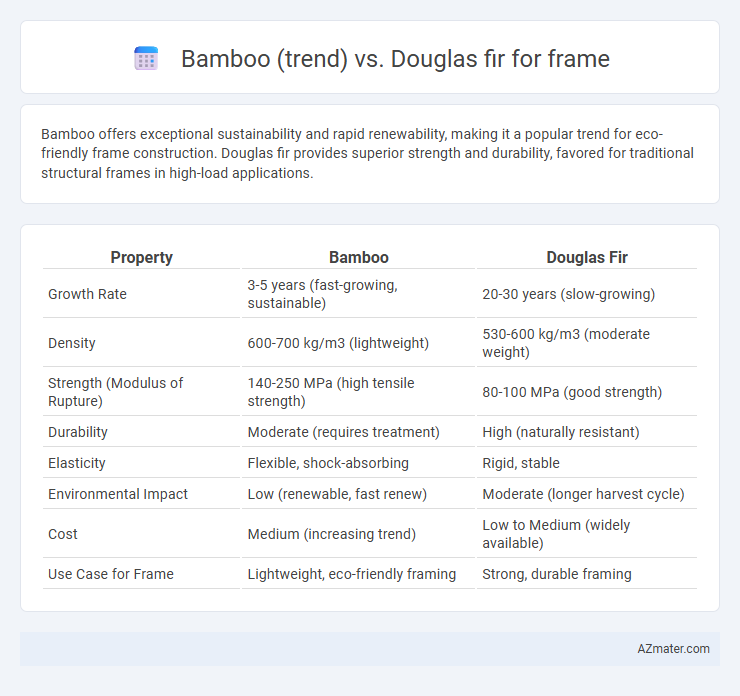Bamboo offers exceptional sustainability and rapid renewability, making it a popular trend for eco-friendly frame construction. Douglas fir provides superior strength and durability, favored for traditional structural frames in high-load applications.
Table of Comparison
| Property | Bamboo | Douglas Fir |
|---|---|---|
| Growth Rate | 3-5 years (fast-growing, sustainable) | 20-30 years (slow-growing) |
| Density | 600-700 kg/m3 (lightweight) | 530-600 kg/m3 (moderate weight) |
| Strength (Modulus of Rupture) | 140-250 MPa (high tensile strength) | 80-100 MPa (good strength) |
| Durability | Moderate (requires treatment) | High (naturally resistant) |
| Elasticity | Flexible, shock-absorbing | Rigid, stable |
| Environmental Impact | Low (renewable, fast renew) | Moderate (longer harvest cycle) |
| Cost | Medium (increasing trend) | Low to Medium (widely available) |
| Use Case for Frame | Lightweight, eco-friendly framing | Strong, durable framing |
Introduction to Bamboo and Douglas Fir Framing Trends
Bamboo framing is gaining popularity due to its rapid growth, sustainability, and high strength-to-weight ratio compared to traditional timber. Douglas fir remains a preferred choice in construction for its durability, straight grain, and excellent load-bearing capacity. Recent framing trends highlight bamboo's appeal in eco-friendly builds, while Douglas fir continues to dominate in structural applications requiring reliability and longevity.
Sustainability and Environmental Impact
Bamboo offers exceptional sustainability due to its rapid growth rate, reaching maturity in just 3-5 years compared to Douglas fir's 30-50 years, significantly reducing carbon footprint and deforestation impact. Bamboo's high strength-to-weight ratio and carbon sequestration capabilities make it an eco-friendly choice for framing, whereas Douglas fir, while durable, demands longer reforestation cycles and intensive resource use. The renewable nature and minimal pesticide requirement of bamboo position it as a superior environmentally responsible material for modern construction frames.
Strength and Durability Comparison
Bamboo exhibits remarkable tensile strength exceeding that of many hardwoods, making it a highly durable choice for framing applications, especially in seismic zones. Douglas fir, known for its high stiffness and load-bearing capacity, offers consistent strength and natural resistance to decay, suitable for traditional heavy framing. While bamboo provides superior strength-to-weight ratio and rapid renewability, Douglas fir remains favored for long-term durability and predictable structural performance in conventional construction.
Cost and Economic Considerations
Bamboo offers a cost-effective alternative to Douglas fir due to its rapid growth cycle and lower cultivation expenses, resulting in reduced material costs for framing projects. Douglas fir, while generally more expensive, provides consistent strength and durability that can translate into long-term savings through reduced maintenance and replacement costs. Economic considerations favor bamboo for budget-sensitive projects aiming for sustainability, whereas Douglas fir remains preferred for high-performance applications requiring proven structural reliability.
Aesthetic Appeal and Design Versatility
Bamboo offers a sleek, modern aesthetic with its smooth texture and light, uniform coloration, making it highly adaptable for contemporary frame designs. Douglas fir presents a warm, natural appearance characterized by prominent grain patterns and rich reddish hues, ideal for traditional or rustic frames. Bamboo's flexibility in shaping and finishing expands creative possibilities, whereas Douglas fir provides robust structural integrity with a classic look suited for versatile architectural styles.
Ease of Sourcing and Availability
Bamboo offers superior ease of sourcing and availability due to its rapid growth cycles and widespread cultivation in tropical regions, making it a sustainable option for framing materials. Douglas fir, while abundant in North America and widely used in construction, faces seasonal constraints and regional supply fluctuations that may impact consistent availability. Manufacturers and builders seeking reliable material supply often find bamboo's year-round harvest potential advantageous over the traditional timber market volatility associated with Douglas fir.
Construction Techniques and Installation
Bamboo frames leverage traditional weaving and lamination techniques that allow for flexible joint connections and rapid assembly, making it ideal for lightweight and earthquake-resistant structures. Douglas fir, favored in conventional construction, requires precise cutting and nailing or bolting with metal fasteners due to its dense, rigid grain, ensuring strong, load-bearing frameworks. Installation of bamboo often involves modular prefabrication and interlocking components, whereas Douglas fir relies on standardized lumber sizing and more labor-intensive on-site adjustments.
Maintenance and Longevity
Bamboo frames require low maintenance due to their natural resistance to pests and moisture, while Douglas fir frames need regular sealing and treatment to prevent decay and insect damage. Bamboo's rapid growth and high tensile strength contribute to exceptional durability, often outperforming Douglas fir in longevity under similar environmental conditions. Douglas fir, despite its traditional use and strength, typically demands more upkeep to maintain structural integrity over time compared to bamboo.
Regulatory Codes and Building Standards
Bamboo frames often face challenges meeting stringent building codes such as the International Building Code (IBC) and ASTM standards due to variability in species and treatment methods, while Douglas fir consistently complies with ASTM D2555 for structural lumber and U.S. building codes given its widespread use and standardized grading. Bamboo requires rigorous testing under standards like ISO 22156 to ensure durability and strength, complicating approval in many jurisdictions compared to the well-documented mechanical properties of Douglas fir. Regulatory acceptance of bamboo is expanding in regions emphasizing sustainable materials, but Douglas fir remains the preferred choice for reliable compliance in framing applications under modern codes.
Best Applications for Bamboo vs. Douglas Fir Frames
Bamboo frames excel in applications requiring lightweight, sustainable, and flexible materials, making them ideal for eco-friendly furniture and interior decor where durability and rapid renewable sourcing are prioritized. Douglas fir frames offer superior strength, stability, and resistance to structural stress, making them the preferred choice for heavy-duty construction, outdoor projects, and load-bearing frameworks. Bamboo is best suited for decorative, lightweight designs and non-structural uses, while Douglas fir dominates in traditional framing requiring high load capacity and resilience.

Infographic: Bamboo (trend) vs Douglas fir for Frame
 azmater.com
azmater.com